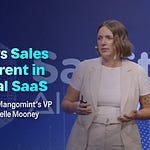The latest 20VC x SaaStr episode with Harry Stebbings, Jason Lemkin, and Rory O’Driscoll is here! The team is discussing Databricks’ $100B valuation, the coming IPO tsunami, CoreWeave’s massive debt raise, AI infrastructure spending that could hit trillions, the return of SPACs as a bubble signal, and why AI tool consolidation will happen faster than anyone expects
Bottom Line Up Front
Harry Stebbings: “We’re seeing the biggest wealth transfer in tech history unfolding before our eyes. When Databricks hits $100B and Andreessen could make $30B on a single deal, we’re not just in a bubble—we’re in a generational moment where the next wave of IPOs could make 2021 look like the appetizer.”
Jason Lemkin: “I think we’re all going to live in AI 24/7 and use 10 times the tokens and 10 times the compute in 24 months. The math is staggering—if we need 200x more infrastructure, how do we even finance that? But here’s the thing: we’ve already automated 5 humans with 10 AI agents at our small team. This isn’t theoretical anymore.”
Rory O’Driscoll: “All this depends on 3-5 more years of continued AI capex expansion. If that’s the case, everything works. If not, all bets are off. We’re way out on the risk curve, and the only thing between us and Armageddon is AI adoption continuing at this pace.”
Databricks Hits $100B: The New Normal for Private Valuations
When Databricks crossed the $100 billion valuation threshold this week, the most telling reaction wasn’t celebration—it was a collective shrug. As Jason noted, “If you’d said 5 years ago there’s going to be a hundred billion dollar market cap private company, you’d be like no way. Now you’ve got Anthropic at $170B, SpaceX at $360B, OpenAI at $500B. The correct response is yeah, whatever.”
But beneath this seemingly blasé attitude lies a fundamental shift in how we value AI infrastructure companies. Databricks is now worth ~50% more than Snowflake while growing 2x as fast—crossing $4 billion ARR at 50% growth versus Snowflake’s $4 billion at 26% growth. At 25x revenue, it actually feels undervalued given the growth trajectory and AI positioning.
The real story here isn’t just another unicorn—it’s about generational wealth creation concentrated in private markets. If Andreessen Horowitz led Databricks’ seed round in 2013 with follow-on investments across multiple funds, they could own 15% of a company heading toward a $200B IPO. That’s potentially $30 billion in returns from a single deal.
“If A16Z invested out of a $650 million fund at the time and they’ve turned a billion and a half into $30 billion, you’re going to feel good in the morning,” Rory observed. “The one thing we don’t take enough into account is just how many people make money when these go out. There are so many LPs in SPVs, SPVs on SPVs. There are dentists who are going to make 5x.”
The Coming IPO Tsunami: Why This Is Just the Beginning
What makes this moment particularly significant is that we haven’t seen the epic IPOs yet. CoreWeave, Circle, Hinge Health, even Figma—these are still “niche plays” compared to what’s coming. As Harry pointed out, “The mega ones are still to come. We might get the next wave of IPOs that are even better very quickly, and the amount of froth that could create in the ecosystem could create a bubble on top of a bubble.”
Consider the pipeline: If Canva IPOs next year at $4 billion ARR growing 40% (versus Figma at $1 billion growing 48%), and if Databricks goes public at an implied $200B valuation, we’re looking at a wealth creation event that dwarfs anything we’ve seen before.
“There’s a significant absolute sum locked up in private markets that at some point is going to seek a public market where a number of them will be worth $50 billion, which is unprecedented. A few will be worth $100 billion and maybe one will be worth a trillion dollars in the private markets,” Rory noted. That trillion-dollar private company prediction isn’t hyperbole—it’s math.
CoreWeave’s $11B Debt Bet: Canary in the Coal Mine or Smart Capital Allocation?
While everyone celebrates Databricks’ equity valuation, CoreWeave’s $11.2 billion debt raise tells a different story about AI infrastructure financing. The company spent $22 billion in capex this year while generating $1 billion in quarterly revenue—a capital intensity that would make even utilities blush.
“Once you decide to spend $22 billion in capex, you’re going to have $11 billion in debt,” Rory explained. “The way you think about CoreWeave is they’re the guys doing the pointy end of the bet that Meta, OpenAI, Anthropic are talking about—we want to deploy a ton of GPUs and data centers. CoreWeave is stepping up as the financing vehicle.”
But this creates a fascinating risk dynamic. CoreWeave becomes the canary in the coal mine for AI demand. “You’re not going to see it in Microsoft. OpenAI isn’t public. You’re not going to see it in Google—they’re too big. But you could see that canary in the coal mine in this public one due to exposure,” Jason observed.
The company’s debt structure depends entirely on matching long-term customer commitments with long-term financing. If Microsoft and OpenAI have seven-year take-or-pay contracts and CoreWeave has seven-year debt, the math works. But if customers start paying rather than taking, or if new data center construction slows, CoreWeave stock could signal broader AI infrastructure headwinds before they show up in hyperscaler earnings.
The Return of SPACs: Peak Bubble Signal?
Nothing says “bubble” quite like Chamath Palihapitiya announcing a new SPAC with the disclaimer that if investors lose everything, they should “embody the adage from President Trump that there can be no crying in the casino.”
“It does seem to remarkably correlate—the return of Chamath to the SPAC market appears to correlate with the most recent bubble in 2021 where it worked in the bubble and didn’t work after,” Rory noted. But the bigger issue isn’t timing—it’s structure. SPACs create adverse selection because promoters get paid when deals get done, regardless of quality.
“If you pay people to do deals, deals get done regardless of quality,” Rory explained. “I just think it’s an imperfect vehicle for fundraising, and the fact that it’s back is indicative of bubbly times.”
The casino metaphor is particularly galling because capital markets aren’t supposed to be zero-sum games. “The point of Wall Street is to funnel money from savers into profitable long-term investments. It’s not a freaking casino, which is a zero-sum game where only the house wins.”
AI Labor Replacement: The Trillion-Dollar Question
Sam Altman’s prediction that AI infrastructure will require “trillions” in spending sounds hyperbolic until you consider the scale of potential labor replacement. Jason’s team has already replaced 5 humans with 10 AI agents, and their AI tool costs are approaching $500,000 annually—heading toward $1 million.
“I think we’re all going to live in AI 24/7 and use 10 times the tokens and 10 times the compute in 24 months,” Jason predicted. “If we’re using AI 20 times more a day and 10 times more tokens, how much more do we need to spend on infrastructure? What’s 200 times today?”
But Rory pushes back on the trillion-dollar timeline: “The $365 billion being invested by the four most profitable companies on the planet is already straining their balance sheets. We’re reaching the limits of what people want to finance.” Even if the direction is right, the pace matters enormously when you’re talking about 4-5% cost of capital on hundreds of billions in investment.
The key insight is that AI adoption needs to transition from technology budgets to human labor budgets to justify trillion-dollar infrastructure spending. “If you see that transition, you’ve got $10 trillion of value unlocked, and then spending trillions becomes a lot more feasible,” Harry noted.
The Consolidation Wave Is Coming Faster Than Expected
One of the most practical insights from the discussion is that AI tool consolidation will happen much faster than the SaaS consolidation cycle. When Jason’s small team is already spending $500,000 annually on AI agents, with every B2B AI startup trying to charge $60-100K per year, the math becomes unsustainable quickly.
“We may see a wave of consolidation in AI even next year because it’s just too many AIs that are six figures and up,” Jason predicted. “Everyone thinks their thing is going to save labor, but you can’t all get credit for the same labor.”
This creates a different dynamic than traditional SaaS, where companies could afford to have dozens of specialized tools. In AI, you might want everything from one vendor in 12 months, which favors companies like Rippling that can bundle multiple AI agents with an orchestration layer.
The implication for venture investing is profound: “We’re ignoring so many risks in AI B2B. Platform risk is everywhere, and we’ve given up worrying about it because the growth is so attractive.”
Fintech’s Global Winners: The Nubank Story
While everyone focuses on AI, Nubank’s $2.5 billion quarterly profit (up 42% year-over-year) with 123 million customers shows what winning looks like in fintech. The Brazilian neobank is now worth $60 billion and has essentially become the primary bank for an entire generation.
“New Bank has 35% market share of Gen Z in Brazil, and Revolut has almost 20% of everyone in the UK with a Revolut account,” Jason noted. This isn’t just fintech disruption—it’s complete market capture.
The success pattern is consistent across geographies: find the weakest, most inefficient part of incumbent banking infrastructure and attack it relentlessly. Nubank went full-stack banking in Latin America, Revolut started with FX in Europe, and Chime focused on deposit arbitrage in the US. The bigger the opportunity (weaker the incumbents), the bigger the outcome.
Revolut’s product expansion strategy is particularly instructive: 26 new products in development, run like internal venture teams with separate funding goals and weekly testing metrics. As Harry observed, “Out of all the founders I’ve interviewed—hundreds and thousands—Nick [Storonsky] is the best I’ve ever met at this playbook.”
Key Takeaways
Private market valuations aren’t crazy when you adjust for growth rates and AI positioning—Databricks at 25x revenue growing 50% actually looks reasonable compared to public comps
The next 12-18 months could see the biggest IPO wave in history, with companies like Canva, Databricks, and Stripe potentially going public at unprecedented valuations
CoreWeave’s debt levels make it the leading indicator for AI infrastructure demand—watch their quarterly results for early signals of market shifts
AI tool consolidation will happen much faster than SaaS consolidation due to budget constraints and the overlap in labor-saving claims
Trillion-dollar AI infrastructure spending is directionally correct but timeline matters—the pace of adoption versus capital deployment costs will determine winners and losers
Successful fintech companies capture entire demographic cohorts, not just market share—35% of Gen Z isn’t just usage, it’s generational platform lock-in
We’re all living in an AI bubble whether we realize it or not—QQQ and VTI exposure means everyone is betting on continued AI infrastructure expansion
Quotable Moments
On the IPO pipeline: “The mega ones are still to come. We might get the next wave of IPOs that are even better very quickly, and the amount of froth that could create in the ecosystem could create a bubble on top of a bubble.”—Harry Stebbings
On bubble dynamics: “If you’d seen a $100 billion private company valuation a year ago, I would have fallen out of my chair. Now it’s funny how I don’t blink an eye in the age of AI.” —Jason Lemkin
On wealth creation: “When Andreessen could make $30 billion on the Databricks IPO, how does that further reinforce the cycle we’re in? 30 billion is a lot.” —Harry Stebbings
On AI infrastructure: “CoreWeave are the guys doing the pointy end of the bet that Meta, OpenAI, Anthropic are talking about. They’re stepping up as the financing vehicle to make that happen.” —Rory O’Driscoll
On consolidation timing: “We may see a lot of these AI folks get consolidated out sooner than happened in the SaaS wave. Everyone wants an agent for their department. They want five or six agents.” —Jason Lemkin
On market risk: “We’re way out on the risk curve, every one of us, right now. The only thing between us and Armageddon is AI adoption. If AI adoption keeps happening, this wagon train keeps rolling. If it slows down, it’s going to get ugly real fast.” —Rory O’Driscoll
On fintech disruption: “New Bank is old bank. If the CEO of Bank of America went to Brazil today, he’d be like, ‘I know exactly what these guys are doing’—banking the middle class, top to bottom.” —Jason Lemkin
On the trillion-dollar question: “Sam Altman said they’re going to spend trillions on infrastructure. Do you think that’s a real number or a metaphor? No company on the planet has spent a trillion dollars in capex ever.” —Rory O’Driscoll









